Non-Auxiliary Fleet: Results of the Unsystematic Development of the Russian Auxiliary Fleet
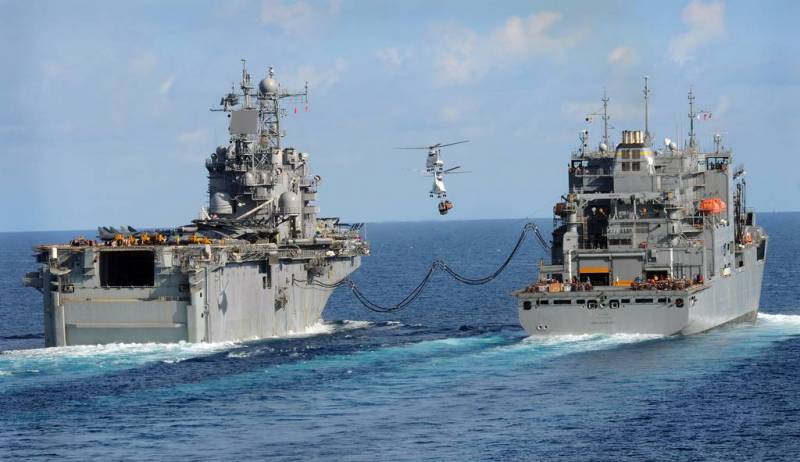
A typical situation for the US Navy is the transfer of fuel on the move and at the same time carrying cargo by helicopters. For the Russian Navy, this is an unattainable level of capability. Photo: US Navy
Since ancient times, warships have needed the support of auxiliary vessels. Even the English sailing ships of the Napoleonic Wars, which are considered to be quite autonomous ships by modern standards, when serving in the Mediterranean and Baltic Seas, needed transports for the delivery of food. When ships were equipped with steam engines, their dependence on auxiliary ships only grew. Let us recall, for example, the armada of coal miners who accompanied the Second Pacific Squadron during the transition to the Far East.
What exactly are auxiliary vessels needed for? Imagine a ship returning to base after completing a training task at sea. For mooring, he needs a tug. As a rule, tugboats from a commercial port are not available in the bases, so the Navy must have its own. You can, of course, show sea dashing and moor without tugs, but from a certain displacement this trick no longer works. Moreover, it will not work in strong winds. Ships, in order not to pollute the water area of the bases beyond measure, must hand over bilge (oil-containing) water - for this, bilge water collector vessels are used. And again, such a vessel, owned by a commercial firm, may be far from the base fleet, so the fleet in a particular base needs its own bilge water collector.
In the event of a threat of a nuclear strike, the fleet command may decide to disperse the basing of ships. Ships will anchor in wild bays where there may be no infrastructure. First of all, they will have to be provided with fuel, water and food. Ammunition, sources of electricity so that the ship does not waste the resource of its generators, and a workshop for the maintenance of the ship will also not be superfluous.
To create such an impromptu base, tankers, weapons transports, and mother ships will be needed. In this case, you will not replace support vessels with any motor transport, and even the USSR did not have enough resources to create coastal infrastructure for ships in every wild bay. Moreover, in the event of a real outbreak of a nuclear war, only the stocks stored on board support vessels will be available to the command, since the bases and arsenals of the fleet can be destroyed.
If you do not believe in the possibility of a nuclear strike, then imagine that all the bases of the fleet in the theater fall within the range of enemy ground-based cruise missiles or sea and air UAVs. Of course, there are air defense bases, but there is always a chance that it will not cope. In addition, such a number of enemy agents live in these bases that they can collect rallies if they wish, and not only track the movements of our ships. In this case, the dispersal of ships in civilian ports and just suitable bays will be a way to make it difficult for the enemy to target them with missiles.
Or let's imagine that Russia has received the go-ahead to establish a forward naval base (or at least a logistics center) in an African country. It is possible, of course, to deploy the construction of coastal infrastructure on the spot, but, as storypower in African countries can change rapidly and unpredictably. And after the change of power, the base will have to be evacuated, leaving all the buildings behind. It is much easier to set up a floating pier in the designated bay and moor a floating workshop to it, which will act as a mother ship, a tanker, a storage ship and, if necessary, a floating barracks. Deployment and evacuation (if necessary) of the base in this case will occur much faster.
When carrying out operations and when carrying out combat service by ships far from their bases, the need for support vessels is obvious. For reference: as part of the squadron of Vice Admiral Nagumo, who attacked Pearl Harbor on December 7, 1941, there were 6 tankers for 14 aircraft carriers and 7 other surface ships. Without refueling at sea, the Japanese fleet could not have carried out this operation.
Since the beginning of the 2000s, the auxiliary fleet of the Navy began to be gradually updated. I would like to consider and analyze the projects of new ships entering the fleet. First of all, ships designed to serve surface ships. Hydrographic and rescue vessels, as well as vessels for servicing nuclear submarines, will not be considered in the article, since one must have specific experience of work / service on these vessels in order to give a competent assessment of their projects.
Project 23120
Multifunctional logistic support vessel (MSTO) of project 23120. The project was developed by St. Petersburg CJSC Spetssudoproekt. 2 ships were built: "Vsevolod Bobrov" (serves at the KChF) and "Elbrus" (serves at the KSF).
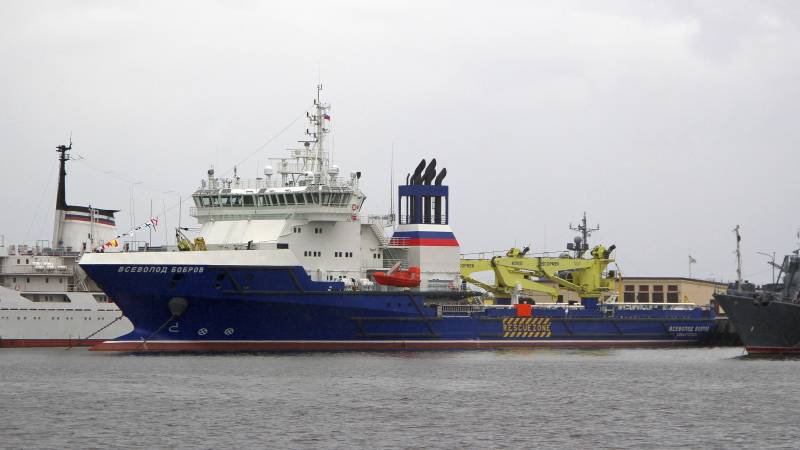
The Vsevolod Bobrov (serial number 881) project 23120 logistic support vessel built at Severnaya Verf Shipbuilding Plant PJSC during the flag-raising ceremony and commissioning into the Russian Navy. Kronstadt, 21.08.2021/XNUMX/XNUMX. Photo: Curious / forums.airbase.ru
Register class: KM Arc4 [1] AUT 1 DYNPOS-2 EPP BWM (ES) Supply vessel.
Register class decoding:
Arc4 - during the summer-autumn period of navigation in the Arctic, the ship can sail in thin first-year ice up to 0,9 m thick. During the winter-spring navigation period in the Arctic, navigation in thin first-year ice up to 0,7 m thick. Year-round navigation in freezing non-Arctic seas in light ice conditions;
[1] - the ship meets the requirements of single-compartment floodability, i.e., it retains buoyancy and stability when one compartment is flooded;
AUT 1 - the volume of ship automation allows it to be operated without the constant presence of a watch in the engine room;
DYNPOS-2 - the vessel is equipped with a dynamic positioning system with a double degree of redundancy;
EPP - the vessel is equipped with a main propulsion electrical installation;
BWM (ES) - the ship manages ballast water through its exchange at sea. This characteristic describes the ship's compliance with international environmental requirements and is irrelevant for describing its functionality;
Supply vessel - supply vessel. In fact, the vessels of project 23120 are analogues of supply vessels that operate to provide drilling rigs on the shelf and underwater operations.
Major TTX
Purpose of the vessel:
• loading, storage, transportation and transfer of dry cargo and fresh water to the shore and ships;
• towing support, assistance to the crews of ships and ships in distress.
Displacement (maximum):
• about 9 tons.
Deadweight:
• about 4 tons.
Full speed:
• 18 knots.
Navigation range:
• 5 miles.
Autonomy by provisions:
• 60 days.
Crew:
• 27 people;
• the ship can accommodate up to 46 people.
Additional devices:
• platform for receiving/transferring cargo from a helicopter in the stern;
▪ hydroacoustic complex based on a multibeam echo sounder;
• pressure chamber (stationary).
Diesel-electric power plant, consisting of:
• four main diesel generators with electric power of 4 kW each;
• two RTOs with coaxial fixed-pitch propellers with a power of 6 kW each;
• parking diesel generator with electric power of 1 kW;
• emergency DG with electric power of 238 kW;
• 2 bow thrusters (NPU).
Dynamic Positioning System:
• keeps the vessel above the positioning point within a circle with a radius of 3 m at current speed up to 1,5 knots, wind speed up to 15 m/s and wave height up to 4 m.
Cargo and towing devices:
• two electro-hydraulic jib offshore cranes with a lifting capacity of 9 meters 50 tons each with a maximum reach of 25 meters (3 tons);
• electro-hydraulic cargo crane with a folding telescopic boom with a lifting capacity of 6 tons with a maximum outreach of 16 m;
• cargo deck with an area of 700 m2, designed for a load of 5 t/m2 and equipped to transport 20- and 40-foot containers;
• max, total weight of deck cargo – 2 tons;
• 2 towing winches with a pulling force of 120 and 25 tons.
The above performance characteristics indicate the approximate displacement (which is not critical) and the approximate deadweight (and this is already important). Unfortunately, different sources give different figures.
The main article in the supply of ships at sea is fuel. The weight of the fuel supplied to the ship when supplying it in combat service is incomparably higher than the weight of technical equipment and provisions. The second article in the supply, comparable (but not equal in volume) is fresh water. But the fact of the matter is that the Project 23120 vessel is not intended for bunkering (refueling) ships at sea and in the base.
Theoretically, closing your eyes to safety precautions, you can pour diesel fuel into a part tanksdesigned for fresh water, and give out fuel for ships from them. But this is a frank palliative from the category bad maritime practice. It is very strange that the "designers" did not provide for the constructive possibility of refueling ships in the project. Many civilian supply vessels (in fact, pr. 23120 is such) are able to take fuel into cargo tanks and transfer it to oil rigs and other vessels at sea.
It turns out that a multifunctional logistics support vessel is not able to satisfy the ships in their main needs. Sending him to combat service just for the sake of transporting dry cargo is somehow illogical. Anyway, the tankers that go with the ships to the BS have dry cargo holds for provisions and other property.
Using project 23120 to supply military garrisons in the Arctic, the Far East, or military bases abroad is also unreasonable. Because this is a relatively large ship with a powerful power plant (main power plant), which consumes a lot of fuel, while the ship has a small carrying capacity. For such purposes, a simpler and smaller vessel is suitable. Structurally, it can be a simple dry cargo ship with an ice class, which, due to a higher displacement utilization factor, will have a lower displacement and lower fuel consumption with the same carrying capacity.
It turns out that the main purpose of pr. 23120 is rescue and underwater work. He can do them perfectly. In addition to towing, the ship is capable of diving. On the extensive cargo deck, autonomous underwater vehicles can be placed, which can be lowered using 50-ton cranes. And the dynamic positioning system allows you to do this even in fresh weather. By installing additional containers, the vessel can even be converted into a cable layer. This conversion takes a couple of days.
Thus, in fact, the fleet received another sea rescue tug with the option of "dry cargo ship plus tanker-aquarius".
Another drawback is the lack of a helipad on the ship, but on a ship with a displacement of 9 tons it could well have been placed somewhere.
Project 20360
Maritime weapons transport. The project was developed by AO KB Vympel. In 2010, one vessel "VTR-79" (serves at the CFL) was put into operation.
Register class: KM * LUZ [1] II SP A2.
LUZ - regular navigation in the small broken ice of the Nearctic seas up to 0,7 m thick;
[1] - the ship meets the requirements of single-compartment floodability, i.e., it retains buoyancy and stability when one compartment is flooded;
II SP - a ship of mixed (river-sea) navigation on waves with a wave height of 3% probability of 6,0 m, with a distance from the place of refuge: in the open seas no more than 50 miles and with an allowable distance between places of refuge no more than 100 miles; in closed seas not more than 100 miles and with an allowable distance between places of refuge not more than 200 miles;
A2 - the scope of automation allows the operation of the mechanical installation of the ship by one operator from the central control room without the constant presence of maintenance personnel in the engine rooms.
Major TTX
Purpose of the vessel:
• acceptance from berths and transfer to ships of special cargoes at base points, in open roads and at sea with waves up to 3 points.
Displacement (maximum):
• 1 tons.
Deadweight:
• 445 tons.
Full speed:
• 10,5 knots.
Navigation range:
• 3 miles.
Autonomy by provisions:
• 10 days.
Crew:
• 23 people.
Single-shaft diesel power plant, consists of:
• 2 Deutz F8M1015MC electric motors with a capacity of 600 hp each. with., working on 2 VFSh;
• 3 diesel generators with a capacity of 318 kW each;
• bow thruster (NPU) with a capacity of 125 kW.
Cargo devices:
• crane with a lifting capacity of 20 tons.
According to pr. 20360, only one vessel was built. The project was considered unsuccessful, the second in the series was completed as an experimental vessel. "VTR-79" is a mixed navigation vessel (river-sea), therefore it can maneuver between fleets along inland waterways.
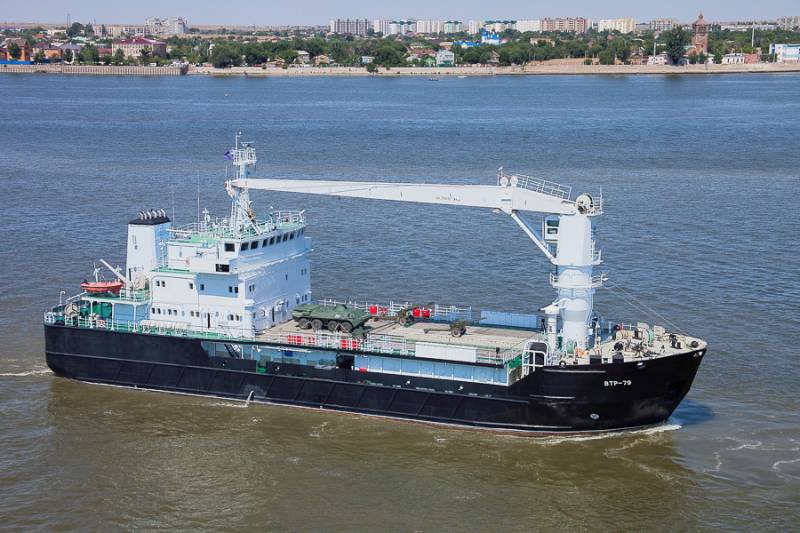 Maritime transport of weapons "VTR-79" project 20360. Photo: Wikipedia
Maritime transport of weapons "VTR-79" project 20360. Photo: Wikipedia20360M project
Maritime weapons transport. The project was developed by AO KB Vympel. At the moment, 2 vessels of this project are being built: "Vladimir Pyalov" (it is assumed that it will serve at the DKBF) and "Gennady Dmitriev" (it is assumed that it will serve at the KChF).
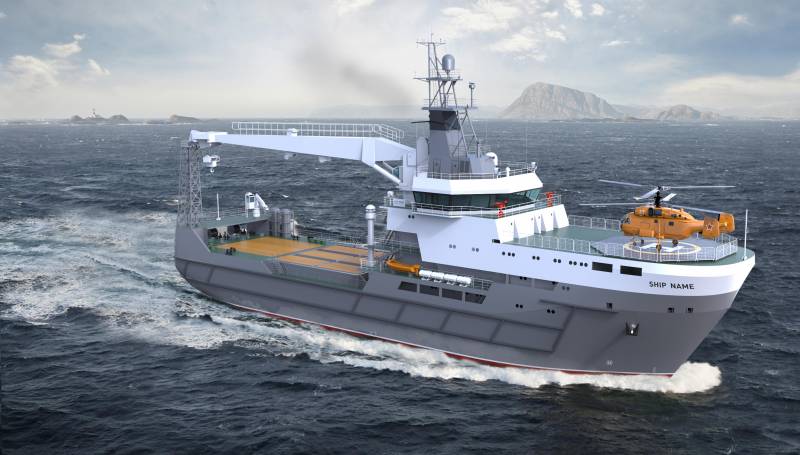 Maritime transport of weapons of the project 20360M. Figure: website of the Vympel ship design bureau.
Maritime transport of weapons of the project 20360M. Figure: website of the Vympel ship design bureau.Major TTX
Purpose of the vessel:
• acceptance from berths and transfer to ships of special cargoes at base points, in open roads and at sea with waves up to 3 points.
Displacement (maximum):
• 3 tons.
Deadweight:
• about 800 tons.
Capacity:
• 400 tons.
Full speed:
• 14 knots.
Navigation range:
• 3 miles.
Autonomy by provisions:
• 30 days.
Crew:
• 25 people;
• the ship can accommodate up to 45 people.
Additional devices:
• Helicopter runway (without basing and refueling).
Single-shaft diesel power plant, consists of:
• 2 azimuth SRCs with a capacity of 2 kW each;
• 3 main diesel generators with a capacity of 1 kW each;
• bow thruster (NPU) with a capacity of 300 kW.
Cargo devices:
• crane with a lifting capacity of 20 tons.
Unfortunately, we could not find a maritime register class for this vessel. But, judging by the photographs, it should have unlimited seaworthiness, unlike Project 20360.
In 2018, the Caspian Flotilla successfully completed exercises on loading Caliber on the high seas onto the Uglich small missile ship from the VTR-79. Therefore, we can say that loading a b / c at sea in good weather (with waves up to 3 points) from the side of pr. 20360 or pr. 20360M is quite a feasible task. Although whether it is necessary to load ammunition on the high seas at all is a moot point, but more on that below. The ship is needed primarily for loading special cargo onto ships in bases.
Etc. 20360 and 20360M can be considered not only as a transport of weapons, but as a military transport for general tasks. For example, at the Kavkaz-2020 exercises, 79 BTR-10A were placed on the deck of the VTR-82, which he floated with his crane during the landing ("This is impossible in a real battle": in Poland, they appreciated the landing of armored personnel carriers from sea transport).
This method of disembarkation cannot be called new or advanced. Back in 1936, in the Pacific Fleet, it was already being practiced for unloading amphibious tanks into the water during landing. Etc. 20360 or 20360M with its 20-ton crane would have looked better in March 2022 in Berdyansk than BDK pr. 1171, which, due to the insufficient carrying capacity of ship cranes, could not unload armored vehicles onto the pier without the help of a floating crane.
Project 03180
Project 03180 multifunctional integrated port service vessel. 4 vessels were built.
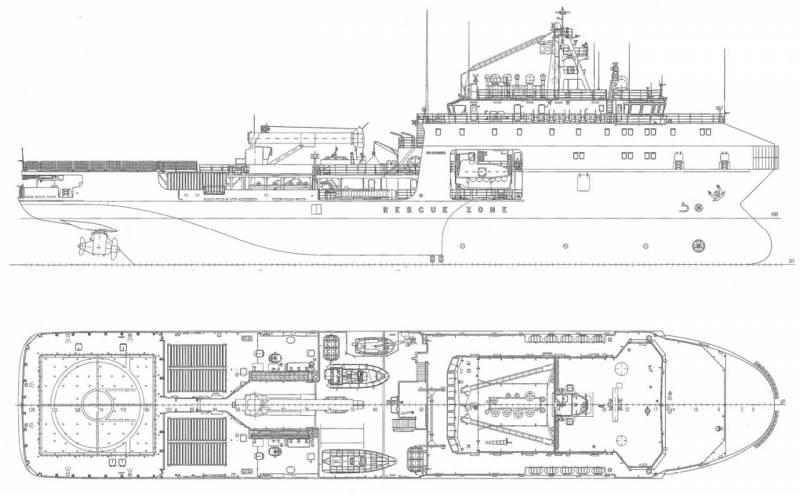
Drawing of the vessel project 03180
Register class: KM Ice3 R2 Aut1 Oil Tanker (>60° C) ESP.
Ice3 - regular swimming in small broken ice of the Nearctic seas up to 0,7 m thick.
R2 - navigation in sea areas in waves with a wave height of 3% probability of 7,0 m, with a distance from the place of refuge not more than 100 miles and with an allowable distance between places of refuge not more than 200 miles.
AUT 1 - the volume of ship automation allows it to be operated without the constant presence of a watch in the engine room;
Oil Tanker (>60 °C) is a sea vessel designed for bulk transportation of oil products with a flash point of more than 60 °C. It means that aviation The ship cannot carry kerosene or gasoline.
Major TTX
Purpose of the vessel:
• acceptance, storage, transportation and transfer of liquid cargoes;
• supplying ships/ships with cargo in barrels, boxes, pallets, etc.;
• collection of bilge, sewage and fecal water, dry garbage and food waste.
Displacement (maximum):
• 2 tons.
Capacity:
• 1 tons.
Full speed:
• 9 knots.
Navigation range:
• 1 miles.
Autonomy by provisions:
• 10 days.
Crew:
• 14 people.
Single-shaft diesel power plant, consists of:
• 2 steerable propellers US 155 from Rolls-Royce, VFSh without nozzle;
• 2 Caterpillar C32 diesel engines with a power of 970 kW each, are used to drive the VRK;
• 3 diesel generators with a capacity of 150 kW each;
• 1 diesel generator with a capacity of 75 kW;
• bow thruster (NPU) with a capacity of 75 kW.
Cargo devices:
• deck crane PK 50002M, Palfinger, with a lifting capacity of 2,5 tons at an outreach of 13,8 meters.
Etc. 03180 is a regular raid/base tanker designed to service ships in bases.
Project 03182
Small sea tanker of project 03182. The project was developed by JSC Zelenodolsk Design Bureau. 1 ship "Vice-Admiral Paromov" was built (serves at the KChF). 3 more ships are being completed.
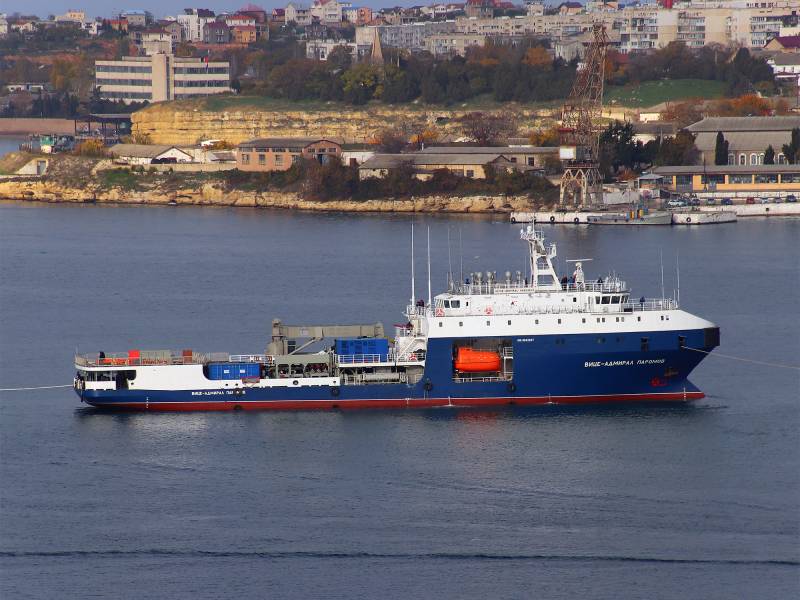
The lead small sea tanker Vice-Admiral Paromov (serial number 850) of project 03182 built by Volga Shipbuilding Plant JSC (Nizhny Novgorod) built in Sevastopol on November 26.11.2020, XNUMX. Photo: A. Brichevsky
Register class: KM ® Arc4 [1] Aut1 Oil tanker.
Arc4 - during the summer-autumn period of navigation in the Arctic, the ship can sail in thin first-year ice up to 0,9 m thick. During the winter-spring navigation period in the Arctic, navigation in thin first-year ice up to 0,7 m thick. Year-round navigation in freezing non-Arctic seas in light ice conditions;
[1] - the ship meets the requirements of single-compartment floodability, i.e., it retains buoyancy and stability when one compartment is flooded;
AUT 1 - the volume of ship automation allows it to be operated without the constant presence of a watch in the engine room;
Oil tanker - oil tanker. Since the cargo flash point limit is not specified in the register class, it can be assumed that the ship can also carry flammable fuels, such as aviation kerosene.
Major TTX
Purpose of the vessel:
• acceptance, storage, transportation and transfer of liquid cargoes;
• supply of vessels/ships with cargoes in barrels, boxes, pallets, containers, etc.;
• collection of bilge, sewage and fecal water, dry garbage and food waste.
Displacement (maximum):
• 3 tons.
Deadweight and carrying capacity:
• deadweight 1 tons (according to other sources, about 560 tons).
The vessel can take up to 200 tons of fuel oil, 400 tons of diesel fuel, 500 tons of fresh water, 100 tons of oily water, 100 tons of sewage and fecal water, 150 tons of other cargo and 235 tons of its own reserves.
Such a load cannot be considered a constant. For example, diesel fuel can be freely taken into tanks intended for fuel oil (before that, the tanks must be thoroughly washed) and, most likely, kerosene can be taken into all ship tanks. In order to understand the exact capabilities of a vessel for the transportation of liquid cargo, one must have access to the technical documentation for project 03182. The author of the article does not have one.
Full speed:
• 14,4 knots.
Navigation range:
• 1 miles.
Autonomy by provisions:
• 30 days.
Crew:
• 24 people;
• the ship can accommodate up to 44 people.
Additional devices:
• Helicopter runway.
Single-shaft diesel power plant, consists of:
• 2 propulsion motors with a capacity of 1 kW each;
• 2 rudder propellers with coaxial fixed pitch propellers;
• 3 diesel generators with a capacity of 1 kW each;
• 2 diesel generators with a capacity of 400 kW each;
• bow thruster (NPU).
Cargo devices:
• cargo crane with a telescopic boom.
Due to the developed forecastle, pr. 03182 is truly a seaworthy vessel. The small cruising range is doubtful, but this can be corrected by using part of the cargo tanks as fuel tanks, to the end user, however, less cargo will reach.
It is possible to refuel ships at sea from the tanker pr. 03182, either by mooring side to side in the sea while drifting, or moving at low speed, or in the wake way. For refueling in the wake way, it is desirable to have a hose winch, but you can do without it.
Unfortunately, nothing is known about the possibilities of basing a helicopter on a ship. But it can be assumed that the necessary equipment and spare parts can be stored in cargo containers located on the deck. Helicopter fuel can be taken into one of the cargo tanks, or in extreme cases, if a cargo tank cannot be used, kerosene can be taken into a tank installed on deck instead of one of the containers. In the presence of hoses and adapters, a competent turner-welder will make a helicopter refueling system from a cargo tank in one day.
There are questions about the carrying capacity of the vessel. If project 03182 is considered as a base/road tanker (or an integrated port service vessel), then the vessel is too complex and expensive. Compare it with pr. 03180. With approximately the same load capacity, pr. 03180 is smaller and cheaper. If we consider pr. 03182 as a sea tanker, then its carrying capacity is insufficient.
General remark on projects 20360, 20360M and 03182 - diesel-electric main power plant (MPP). Why is she on these courts? Basically, they are transport ships. Due to the VRK, NPU and small size, they have fairly good maneuverability. They do not need any unique maneuverability to work. These are not icebreakers and not tugboats. Diesel-electric power plants are more expensive to manufacture and maintain than diesel ones; requires more staff to operate. As a result, it only increases the cost of ships without any visible benefit.
Project 23130
Medium sea tanker (SMT) of project 23130. The project was developed by ZAO Spetssudoproekt JSC. 1 vessel "Akademik Pashin" was built (serves at KSF). Another 3 vessels of this project were laid down in 2021–2023.
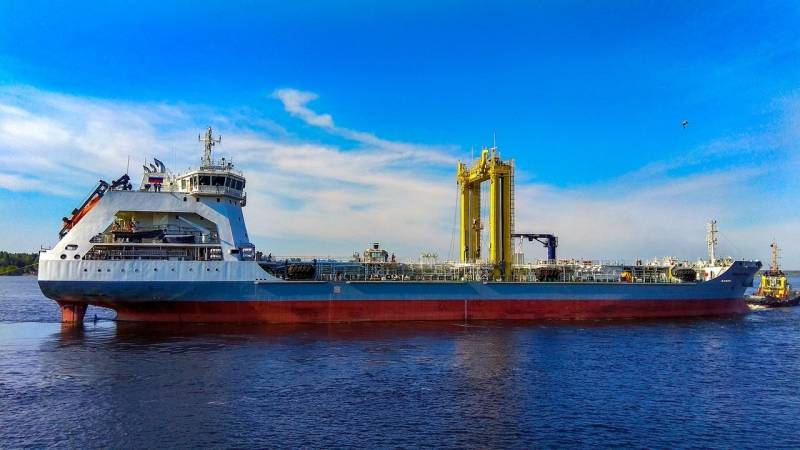
SMT "Akademik Pashin". Photo: Alexander Ivanov
Register class: KM Arc4 AUT1 VCS IGS-NG CCO Oil tanker (ESP).
Register class decoding:
Arc4 - during the summer-autumn period of navigation in the Arctic, the ship can sail in thin first-year ice up to 0,9 m thick. During the winter-spring navigation period in the Arctic, navigation in thin first-year ice up to 0,7 m thick. Year-round navigation in freezing non-Arctic seas in light ice conditions;
AUT 1 - the volume of ship automation allows it to be operated without the constant presence of a watch in the engine room;
VCS - the ship is equipped with a system for issuing cargo vapors. Such systems are installed on some oil and chemical tankers. They are used during loading so that the cargo vapors displaced by the cargo do not go directly to the deck of the tanker through the breather valves, but go ashore for disposal;
IGS-NG - the ship is equipped with an inert gas source in the form of a nitrogen generator. Such a generator produces a gas mixture consisting of 95% nitrogen and 5% oxygen. This mixture is needed to fill the free space above the cargo in the cargo tank. This is necessary to improve the safety of transporting flammable goods, such as aviation kerosene;
CCO - the vessel is equipped with a cargo operations control post;
Oil tanker - oil tanker;
(ESP) - means the need for an extended survey of a ship in accordance with the International Code for an extended program of inspections during surveys of oil tankers. This characteristic is only relevant for civil ships and does not describe the functionality of the ship.
Major TTX
Purpose of the vessel:
• acceptance, storage, transportation and transfer at sea and in the base of liquid cargoes: diesel fuel, marine fuel oil, aviation kerosene, engine oil, water; dry cargo: food, skipper and technical equipment.
Displacement (maximum):
• 14 tons.
Deadweight and carrying capacity:
• deadweight – 9 tons;
• carrying capacity - 7 tons.
In one trip, an average marine tanker can take up to 3 tons of fuel oil, 000 tons of diesel fuel, 2 tons of aviation kerosene, 500 tons of lubricating oil, up to 500 tons of fresh water, as well as 150 tons of food and various equipment and spare parts. As with project 1, the specific loading of the vessel may vary.
Full speed:
• 16 knots.
Navigation range:
• 8 miles.
Autonomy by provisions:
• 60 days.
Crew:
• 24 people;
• the ship can accommodate up to 36 people.
Single-shaft diesel power plant, consists of:
• 2 main medium-speed, four-stroke, non-reversible Wärtsilä diesel engines with a capacity of 4 kW each;
• controllable pitch propeller (VRSh);
• 2 Wärtsilä diesel generators with a capacity of 750 kW each;
• bow thruster (NPU).
Cargo devices:
• device for transfer of liquid cargoes by traverse method has the ability to transfer fuel oil, diesel fuel, aviation fuel, oil, fresh water. The throughput of the device is about 400–600 tons/h. The possibility of simultaneous transfer of goods from two sides is provided;
• a device for the transfer of dry cargo and people in a traverse way, with a carrying capacity of up to 2 tons;
• a device for the transfer of liquid cargo in the wake way. The throughput of the device is about 150 tons / h;
• a cargo platform is provided in the bow for transferring dry cargoes by helicopter without landing on the deck;
• a cargo crane with a telescopic boom with a lifting capacity of 2,7 tons with a maximum outreach of up to 20 m.
"Akademik Pashin" is a tanker of classical architecture without any frills in design. However, there are comments on the design of the vessel.
Firstly, the vessel does not have a helipad and a helicopter basing system. Which looks a little weird. On ships of smaller displacement, designed to service ships in the near sea zone or in the base (project 03182 and project 20360M), there is a helipad, but there is no helipad on the ship of the far sea zone, project 23130.
By the way, most similar foreign ships have helipads and sometimes hangars for helicopters.
Secondly, only 2 diesel generators provide the ship with electricity. For normal redundancy, 2 generators are not enough. Traditionally, 3 diesel generators are installed on civilian ships.
The author of the article twice worked on ships that had two auxiliary diesel generators plus a shaft generator. Both had a situation where there was only one serviceable generator left, while the ships were carrying out cargo operations and a second generator would be very useful. A similar situation on a support vessel can lead to a failure of the task. Three 3 diesel generators would have looked better on project 23130.
Thirdly, no source indicates that project 23130 can supply ships with ammunition. For their transportation, a specially equipped hold is needed, but there is no such hold on the ship. Although making it is not a super task for shipbuilders. Perhaps, due to the small size of the vessel, it would not be able to transport the entire range of ammunition, but such as artillery or aviation ammunition, the vessel of project 23130 could transport and even reload onto ships at sea.
Of course, it is possible to load ammunition into a conventional hold, but according to the experience of 2022, it is known that they tend to sometimes explode on board, with dramatic consequences for ships. So it's better not to do that.
The question of whether it is worth replenishing the ammunition of ships at sea is open - there is no definite answer. But aircraft carriers are an exception. They can work on coastal targets for several days, then load up on fuel and ammunition at sea and continue combat work. But loading something onto an aircraft carrier (or TAKR) is not so easy, because of the collapse of the sides, it is impossible to simply approach and moor to it.
For mooring, it is necessary to install a pontoon between the supply vessel and the ship. It is impossible to carry such a pontoon with you to military service. Therefore, a ship is needed that is capable of transferring ammunition in a traverse way, and the Akademik Pashin, which must transfer cargo in this way, cannot, strictly speaking, transport ammunition.
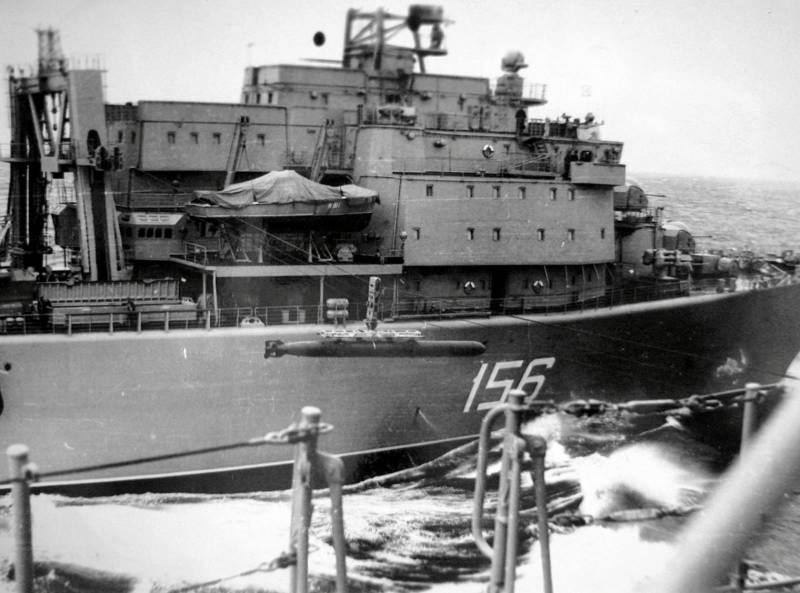
Transfer of a torpedo to a warship from the Berezina integrated supply ship. Photo: Balancer Forum (Airbase forum).
You can transfer b / c from the board of Elbrus. Due to the dynamic positioning system, it can go in a parallel course and strictly maintain the distance and speed relative to the TAKR.
At the same time, he will reload ammunition and supplies using a hydraulic crane to the aircraft lift platform, at the level of the hangar deck. Not sure if this is a working method, but it is a way you can try. Preferably at the beginning on empty boxes. But then again, Elbrus is not designed to transport ammunition. Although they can be loaded into containers and transported on deck.
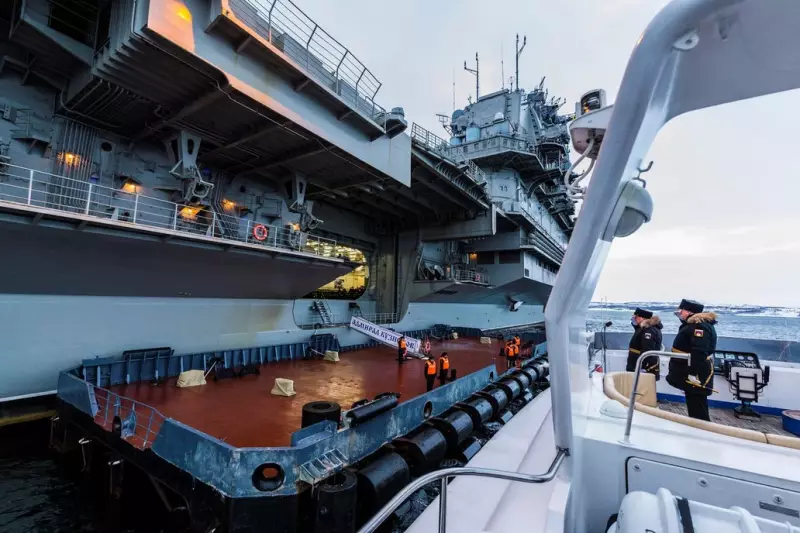
Barge spaced for Kuznetsov. Photo: Murmansk region / Vk.com.
It is possible to reload b / c from the side of the 20360M weapons transport, but this vessel does not have a dynamic positioning system (and if it does, then this is not mentioned in open sources). And he will not be able to go in fresh weather on a parallel course 15–20 meters from the TAKR.
So it turns out that the only ship that is now adapted for loading ammunition on the TAKR is not adapted for their transportation. You can, of course, as in the famous combat service of the TAKR "Kuznetsov" in the Mediterranean Sea in 2017, load ammunition on board a ship on the high seas using a floating crane, but this is possible only in ideal weather near the base, since a crane cannot operate in the same order as ships.
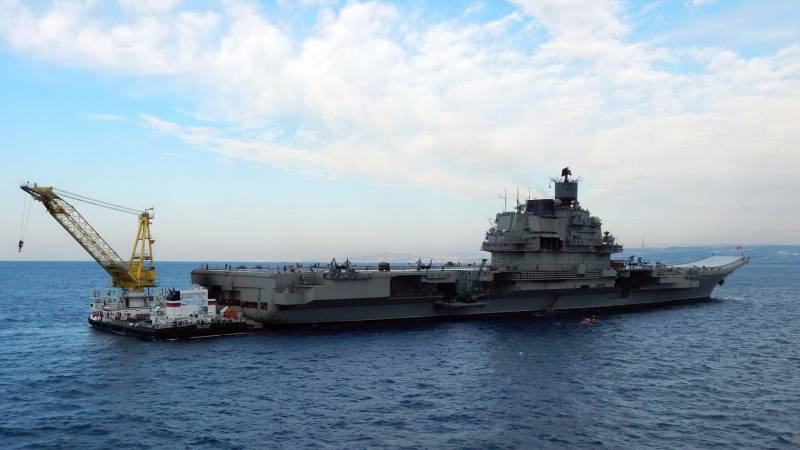
Kuznetsov and a floating crane when loading ammunition. Photo: Balancer Forum (Airbase forum).
A positive feature of the project is that it meets modern environmental requirements. This can greatly facilitate the entry of a vessel into foreign ports for loading fuel, water and provisions. In extreme cases, you can change the flag of the auxiliary ship to the flag of a regular merchant ship on the ship. The register class allows you to do this, and this was sometimes done in Soviet times. Not all countries, of course, will now let a Russian merchant ship into the port, but there are also “hesitant” ones.
And now consider the main characteristics - the carrying capacity and speed of the vessel. 7 tons and 250 knots - is it a lot or a little? Here is what is written in the book “The Navy of the USSR 16–1945” (V. P. Kuzin, V. I. Nikolsky) about the experience of operating the KKS pr. 1991 Berezina:
Foreign counterparts had a travel speed of 25-26 knots, which allowed them to operate as part of aircraft carrier formations, without constraining them with their presence, because when working with aviation, the average connection speed was 23-24 knots.
The main performance characteristics of refueling tankers and KKS of Great Britain, the USA, China and the USSR.
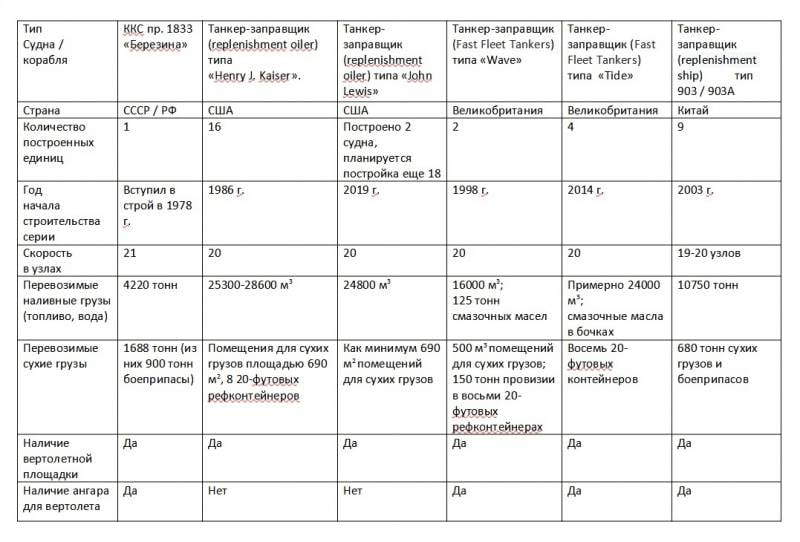
The table does not include small sea tankers, water tankers, offshore and special tankers.
As you can see, project 23130 can replace the SMT built in the 60s and 70s, but it will not replace the Large Sea Tanker (BMT). Of course, one can say that Russia's interests lie in the near sea zone (BMZ), and we don't need big tankers. But then why are ships of a very respectable age still kept in service - BMT pr. 1559V?
The idea that pr. 23130 is too small seems to have occurred to someone in the RF Ministry of Defense, and on December 26, 2014, two tankers of project 23131 with a deadweight of 12 tons were laid down at the Zaliv plant in Crimea. By 000, these ships have not been built, and there is no longer any hope that they will ever be. In 2023–2021, 2023 more tankers, pr. 3, were laid down. Apparently, later it was considered that a deadweight of 23130 tons (9 tons) was enough.
There is a saying: "We are not rich enough to buy cheap things." Perhaps it characterizes pr. 23130 well.
The Russian Federation has few modern support vessels for DMZ. They are being built for a long time (5 years have passed from the laying of the "Academician Pashin" to the end of the tests). Therefore, from each of them I would like to get the maximum. In a good way, in place of the vessel pr. 23130 there should be a tanker of a larger displacement, with a wide range of capabilities and a higher speed.
It is worth paying attention to how many names of foreign components are in the description of the ships. At least 3 out of 6 projects have foreign diesel engines or electric motors as part of the power plant. How will these ships be serviced and how will the already laid down ships be completed under sanctions?
When describing each type of vessel, the presence or absence of a helipad and conditions for its basing were mentioned. Ship helicopters the fleet needs it, and the more there are, the better, but there are not enough carriers of these helicopters.
The use of support vessels as helicopter carriers is, of course, a palliative. But when you read how the Deputy Fleet Commander for MTO, Major General, having taken command of the floating crane, led him with a load of equipment to about. Zmeiny, under the cover of "anti-aircraft missile systems deployed on support vessels" (c), you understand that the time when one could be ashamed of palliatives has passed.
Now we need to use all possible methods. The British, when they sent a formation of ships to the South Atlantic in 1982 to recapture the Falkland Islands, placed helicopters on all ships, auxiliary and mobilized civilian vessels on which they could be placed.
As you can see from the ships described in the article, all except the Akademik Pashin tanker are more suitable for supporting and servicing ships in bases. And just in the bases, you can use ships mobilized / chartered / bought from the civilian fleet. Even rescue tugs, if necessary, the Navy can mobilize from the Marine Rescue Service.
But there are no high-speed tankers with the possibility of traverse refueling at sea in the civil fleet. The next vessels, project 23130, will appear only in 2026–2027. If they show up at all. In the meantime, the fleet will use tankers built in the 60s and 70s in the DMZ. How much longer will they last?
Above are the performance characteristics of the latest support vessels. They can be discussed, they can be argued about, but when we talk about MSTO pr. 23120, the question arises: what is the functionality of this vessel? Offhand, for the price of two vessels of project 23120, you can build at least one tanker, project 23130, which, although not the pinnacle of ship architecture, is at least clear in its purpose. The construction of the MSTO "Vsevolod Bobrov" and "Elbrus" is a sign of the absence systems in the order and construction of auxiliary vessels. It seems that the Defense Ministry does not clearly understand how the fleet will be used in a future war, and, accordingly, cannot understand what ships are needed to support it.
In the USSR, auxiliary vessels were needed primarily to service ships in bases, to ensure dispersed basing and to provide ships in combat service in Peaceful time. With the outbreak of war, operational squadrons attacked American ships deployed in theaters of operations. After that, these squadrons would most likely be destroyed. For such a task, the USSR built many fairly simple support vessels (primarily tankers). The only built KKS "Berezina" was found to be too expensive. And for the doctrine of the Soviet Union it was logical. For the price of one KKS, it was possible to build a couple of simpler tankers, which were preferable.
The US Navy has a different doctrine. American ships / support ships are designed to support the actions of ships at sea for a long time, they must go in the same order as warships and, accordingly, have a high speed. The United States has fast combat support ships. For auxiliary ships, they are relatively expensive, but they have a place in the American fleet doctrine. Therefore, their construction is logical.
And what is the doctrine of the use of auxiliary vessels in the modern Russian fleet?
Do we have a system with precisely set priorities in the development of technical specifications for supply ships, or does the industry simply build what it wants and what it can do in order to master the state money?
Apparently, the second answer is the correct one.
Information